Europe Video Conferencing Hardware Market Size
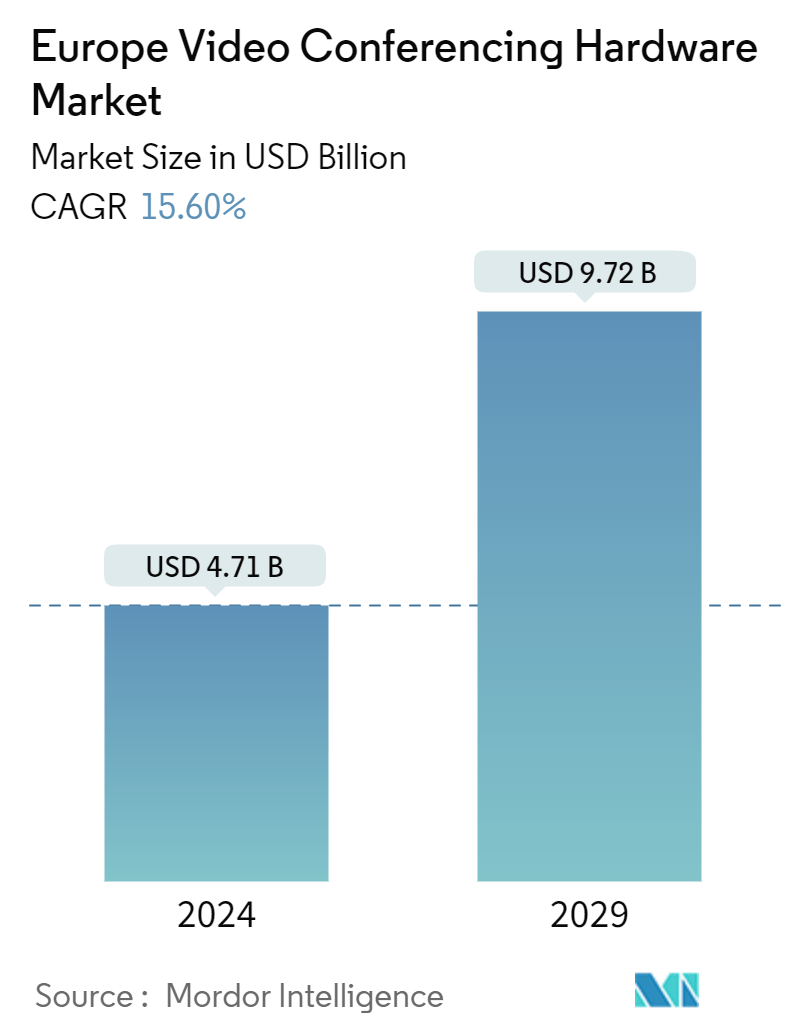
| Study Period | 2022 - 2029 |
| Base Year For Estimation | 2023 |
| Market Size (2024) | USD 4.71 Billion |
| Market Size (2029) | USD 9.72 Billion |
| CAGR (2024 - 2029) | 15.60 % |
| Market Concentration | High |
Major Players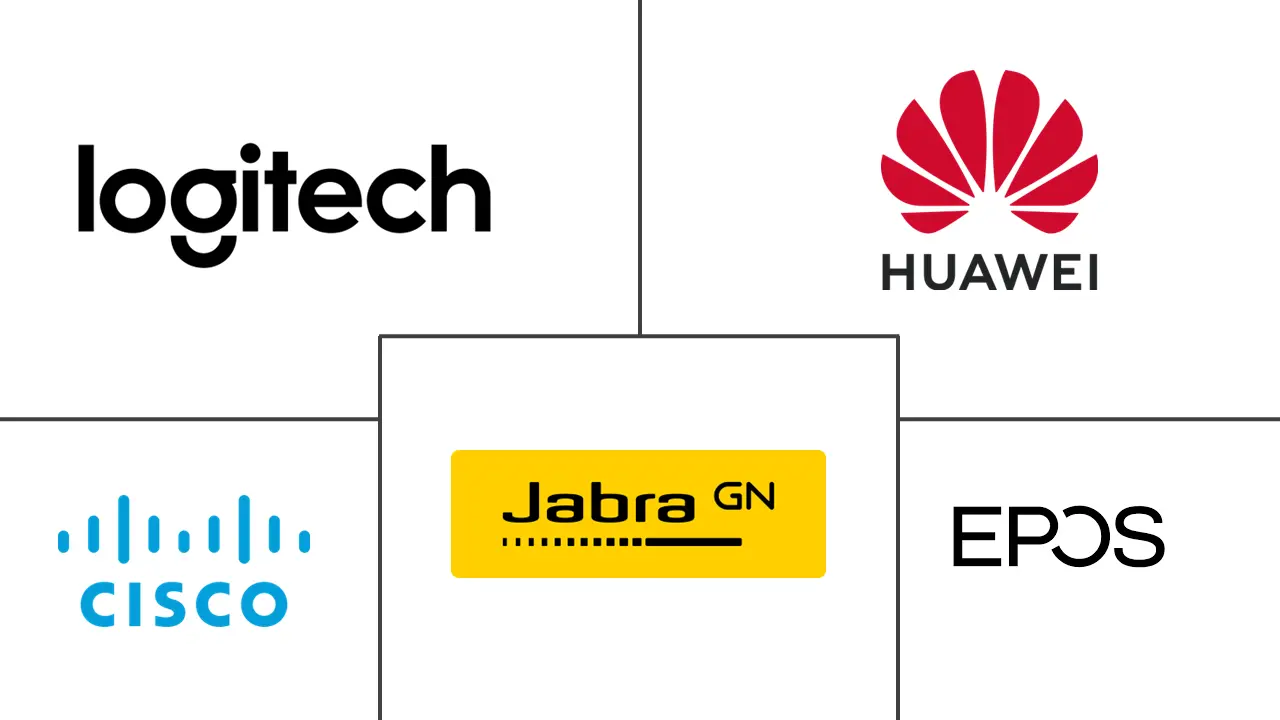
*Disclaimer: Major Players sorted in no particular order |
Europe Video Conferencing Hardware Market Analysis
The Europe Video Conferencing Hardware Market size is estimated at USD 4.71 billion in 2024, and is expected to reach USD 9.72 billion by 2029, growing at a CAGR of 15.60% during the forecast period (2024-2029).
The European video conferencing hardware market is undergoing drastic change due to changes in work culture and workplaces. The growing demand for real-time and flexible video conferencing devices drives market growth. Technological advancements in hardware such as cameras, MCUs, codec systems, enterprise headsets, and USB-based integrated bars drive the market. Further, the increased adoption of hybrid work culture fuels market growth.
Cameras are vital in video conferencing and remote communication in the digital world. High-resolution cameras are in high demand due to the growing need for remote collaboration solutions and the growth of remote work culture. Major players in the video conferencing market, such as Hikvision, Logitech, Sony, Dahua, and Huawei, are constantly investing in R&D to develop innovative camera solutions with cutting-edge technology to meet consumer demand. Such developments are expected to drive market growth.
The constant innovation and upgradeability of the existing hardware create tremendous market opportunities. The development of MCUs speeded up group meetings by allowing easy integration of inputs from different sources. MCUs ensure that each participant in the video call shares the same collective feed by connecting the various streams of video, audio, and data into a single broadcast. Modern MCUs also include advanced features such as transcoding, which increase their capacity to handle multiple participants with variable codec request bandwidth. Thus, the improved features and hardware capabilities are expected to attract more consumers in the coming years.
According to Eurostat, in 2023, 12% of the employed people worked from home in the European Union compared to 10.2% in 2022. Estonia recorded the highest number of people working from home. The share of work-from-home workers changed broadly between European countries, with 25% of Irish workers working from home in 2022, compared to 1.4% of Romanian workers during the same period. Women mainly work from home compared to men. However, this was reversed in some countries; for example, in Ireland, around 26% of men regularly worked from home in 2022.
Also, the growth of the 5G network further accelerated the adoption of video conferencing solutions as technology helped to reduce latency and increase network speed for the users. Data security concerns and poor audio/video quality or software glitches hinder market growth. Technical issues in audio or video hardware devices will restrict the market growth. In addition, low network bandwidth and connectivity issues with USB cameras, speakers, or microphones may hamper market growth.
The Russia-Ukraine war put pressure on the global supply chain, which significantly hampered electronics production due to the availability of raw materials. Such factors are expected to hinder market growth. Moreover, the increased inflation and economic slowdown across the major European countries decreased consumer spending, resulting in low demand for video conferencing hardware.
Europe Video Conferencing Hardware Market Trends
Institutions are Expected to Hold Significant Market Share
Europe is home to the world's best universities, including the University of Oxford, the University of Cambridge, the University College London, and Imperial College London. The adoption of video conferencing hardware in European institutions such as schools, colleges, and universities has significantly increased, accelerating the shift to online learning.
Universities and higher education institutions in Europe are mainly focusing on adopting the latest technologies and offering online and distance learning to international students. Thus, universities and institutions invest in high-quality cameras, microphones, and speakers to enhance video and audio quality in online lectures and seminars. These cameras range from basic webcams to DSLR cameras with HDMI outputs, allowing clear and crisp video transmission. The continuous development in camera and audio technology further supports market growth.
As hybrid becomes the new norm, teachers must be ready to set up remote classes from anywhere, and flexible technology helps them connect to students where they teach. Video conferencing hardware is used for live virtual classes, one-on-one meetings with teachers, group study sessions, and tutoring sessions. This helps to improve student-teacher communication and supports students' progress in their coursework.
Further, many European universities are integrating video conferencing hardware with learning management systems to streamline the virtual learning experience. For example, at Heidelberg University, the demand for digital events in research, teaching, and administration was met by the video conferencing systems provided by the university. In addition, the European University Institute (EUI) stated that as of January 2023, conference, meeting, and seminar rooms were equipped with a video projector and screen, laptop, speakers, and microphones.
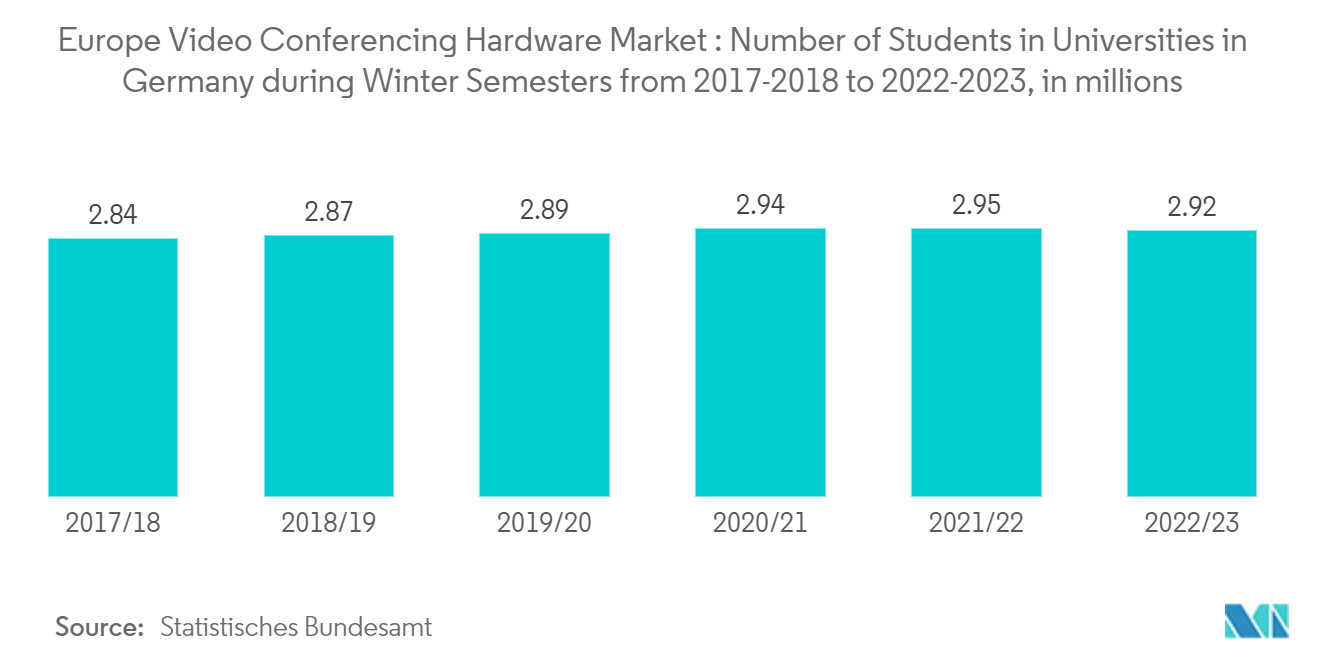
Germany is Expected to Hold Significant Market Share
With the rise of a hybrid work environment in which employees split their time between working remotely and in the office, there is a growing demand for video conferencing hardware that supports seamless collaboration between remote and on-site team members. The Ifo Institute for Economic Research, based in Munich, stated in a recent study that around 24.1% of workers in Germany worked at least partially from home in February 2024.
As one of Europe's largest countries, Germany ranked sixth in the Global Remote Work Index 2023 (GRWI). Although the country will become less accessible to international workers after Brexit, it is an attractive option for remote work. In addition, businesses nationwide are focusing on hybrid working to increase employee productivity.
German organizations are gradually adopting a working model that effortlessly combines at-home, in-office, and on-the-go work culture and are focusing on investment in end-user technology, which supports this pattern. The 2023 ISG Provider Lens Future of Work Services report for Germany suggests that businesses concentrating on workplace well-being and employee experience through hybrid reality will be better positioned to attract and retain the talent necessary for success.
Germany is home to around 420 higher education institutions and universities. During the 2022-2023 winter semester, 423 higher education institutions were in Germany. Institutions are widely adopting video conferencing hardware to support online teaching. For instance, Berlin International University of Applied Sciences implemented video conferencing hardware across its colleges and departments to support remote seminars, lectures, and meetings. The university adopted Logitech Rally, which supports a hybrid learning model that transformed lectures and seminars at BI into video conferencing meetings, providing a contemporary experience for all students and teachers.
With the advent of cloud computing and other hosted technology services, there has been a surge in the use of remote working, mobile collaboration, and videoconferencing. With advanced tools available across a wide range of endpoints, such as mobile, room-dedicated collaboration systems, and desktops, communication is becoming lighter and more agile, bringing together the best and most important elements of collaboration regardless of the user’s location.
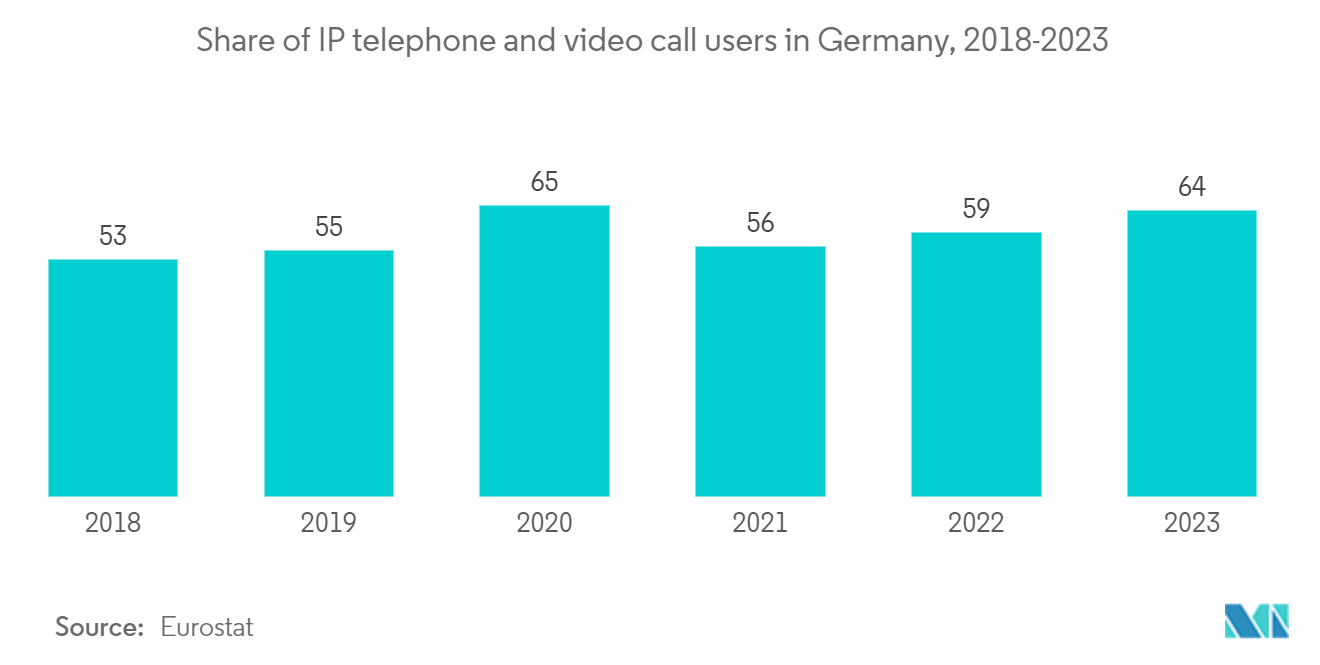
Europe Video Conferencing Hardware Industry Overview
The European video conferencing hardware market is consolidated and dominated by leading vendors, such as Jabra Inc., Cisco Systems Inc., Logitech International SA, Huawei Technologies Co. Ltd, and EPOS. Companies continuously focus on enhancing their market presence by launching new products, expanding their operations, or entering strategic mergers and acquisitions, partnerships, and collaborations.
- In March 2024, Logitech International launched Mevo Core, a next-generation live-streaming camera. The new 4K camera is designed for content creation and live streaming and can be controlled from a tablet or smartphone.
- In March 2024, Cisco launched new, multifunctional devices that provide modernized collaboration experiences to a hybrid workforce. The new Cisco Board Pro G2 device is a touch-enabled, AI-powered collaboration device. The Cisco Desk Phone 9800 Series is designed to bring a personalized and modern productivity hub to any desk. Cisco Board Pro G2 offers optimized camera views that help improve hybrid teamwork.
Europe Video Conferencing Hardware Market Leaders
-
EPOS
-
Cisco Systems Inc.
-
Logitech International S.A.
-
Jabra Inc.
-
Huawei Technologies Co., Ltd.
*Disclaimer: Major Players sorted in no particular order
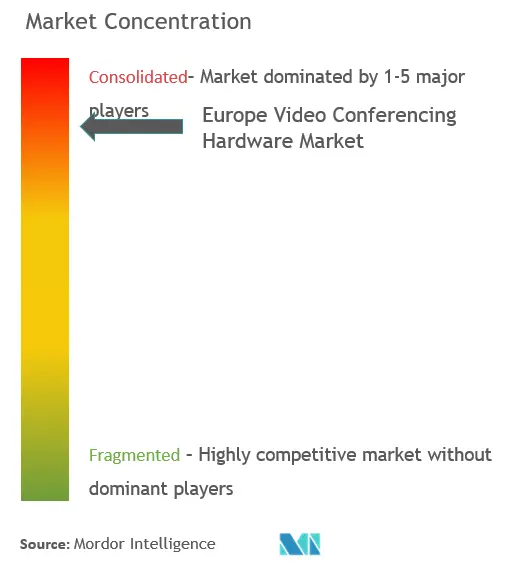
Europe Video Conferencing Hardware Market News
- March 2024: Logitech launched MX Brio/MX Brio 705 for Business, a revolutionary high-end webcam for end users and enterprises, designed to meet the demanding needs of advanced users. MX Brio is Logitech’s most advanced webcam yet and joins the Master Series ecosystem alongside MX keyboards and mice to deliver outstanding performance and streaming experiences, while fostering quality collaboration. The Ultra HD 4K webcam helps creative professionals and developers elevate their virtual presence and efficiently share results and ideas.
- September 2023: ASBISC Enterprises PLC brand, Prestigio Solutions, launched the innovative 4K PTZ Camera Alpha developed to improve the video conferencing experience. The new camera integrated with a Sony sensor produces clear images with outstanding 4K resolution at 60 frames per second.
Europe Video Conferencing Hardware Market Report - Table of Contents
1. INTRODUCTION
1.1 Study Assumptions and Market Definition
1.2 Scope of the Study
2. RESEARCH METHODOLOGY
3. EXECUTIVE SUMMARY
4. MARKET INSIGHTS
4.1 Market Overview
4.2 Industry Attractiveness - Porter's Five Forces Analysis
4.2.1 Threat of New Entrants
4.2.2 Bargaining Power of Buyers/Consumers
4.2.3 Bargaining Power of Suppliers
4.2.4 Threat of Substitute Products
4.2.5 Intensity of Competitive Rivalry
4.3 Impact of COVID-19 Aftereffects and Other Macroeconomic Factors on the Market
5. MARKET DYNAMICS
5.1 Market Drivers
5.1.1 Technological Development in Camera and MCUs
5.1.2 The Adoption of Hybrid or Remote Work Methods by Regional Organizations
5.2 Market Challenges
5.2.1 Data Security Concerns
6. MARKET SEGMENTATION
6.1 By Type of Hardware
6.1.1 Multi Control Units (MCU)
6.1.2 Collaboration Bars
6.1.3 Codec Systems,
6.1.4 USB Cameras
6.1.5 USB-based Integrated Bars
6.1.6 Other Bundled Kits
6.1.7 Enterprise Headsets
6.2 By End User
6.2.1 Institutions
6.2.2 Commercial Spaces
6.3 By Country***
6.3.1 United Kingdom
6.3.2 France
6.3.3 Germany
6.3.4 Italy
7. COMPETITIVE LANDSCAPE
7.1 Company Profiles*
7.1.1 Cisco Systems Inc.
7.1.2 Logitech International SA
7.1.3 EPOS
7.1.4 Jabra Inc.
7.1.5 Poly Inc.
7.1.6 Huawei Technologies Co. Ltd
8. Market Outlook
Europe Video Conferencing Hardware Industry Segmentation
The study tracks the revenue accrued by various players in the European market selling video conferencing hardware. It also tracks the key market parameters, underlying growth influencers, and major vendors operating in the industry, which will support the market estimations and growth rates during the forecast period. The study further analyses the overall impact of the COVID-19 pandemic aftereffects and other macroeconomic factors in the market. The report’s scope encompasses market sizing and forecasts for the various market segments.
The European video conferencing hardware market is segmented by product (multi control units (MCU), collaboration bars, codec systems, USB cameras, USB-based integrated bars, other bundled kits, enterprise headsets), end user (institutions and commercial spaces), and country (United Kingdom, Germany, France, Italy, and Rest of Europe). The market sizes and forecasts regarding value (USD) for all the above segments are provided.
| By Type of Hardware | |
| Multi Control Units (MCU) | |
| Collaboration Bars | |
| Codec Systems, | |
| USB Cameras | |
| USB-based Integrated Bars | |
| Other Bundled Kits | |
| Enterprise Headsets |
| By End User | |
| Institutions | |
| Commercial Spaces |
| By Country*** | |
| United Kingdom | |
| France | |
| Germany | |
| Italy |
Europe Video Conferencing Hardware Market Research FAQs
How big is the Europe Video Conferencing Hardware Market?
The Europe Video Conferencing Hardware Market size is expected to reach USD 4.71 billion in 2024 and grow at a CAGR of 15.60% to reach USD 9.72 billion by 2029.
What is the current Europe Video Conferencing Hardware Market size?
In 2024, the Europe Video Conferencing Hardware Market size is expected to reach USD 4.71 billion.
Who are the key players in Europe Video Conferencing Hardware Market?
EPOS, Cisco Systems Inc., Logitech International S.A., Jabra Inc. and Huawei Technologies Co., Ltd. are the major companies operating in the Europe Video Conferencing Hardware Market.
What years does this Europe Video Conferencing Hardware Market cover, and what was the market size in 2023?
In 2023, the Europe Video Conferencing Hardware Market size was estimated at USD 3.98 billion. The report covers the Europe Video Conferencing Hardware Market historical market size for years: 2022 and 2023. The report also forecasts the Europe Video Conferencing Hardware Market size for years: 2024, 2025, 2026, 2027, 2028 and 2029.
Europe Video Conferencing Hardware Industry Report
Statistics for the 2024 Europe Video Conferencing Hardware market share, size and revenue growth rate, created by Mordor Intelligence™ Industry Reports. Europe Video Conferencing Hardware analysis includes a market forecast outlook for 2024 to 2029 and historical overview. Get a sample of this industry analysis as a free report PDF download.



